2010 JAGUAR XFR heater
[x] Cancel search: heaterPage 2297 of 3039

DTC Description Possible Cause Action B116311
Left Mirror Heater
Output
Left mirror heater control
circuit - short to ground Refer to the electrical circuit diagrams and test left mirror
heater control circuit for short to ground B116315
Left Mirror Heater
Output
Left mirror heater control
circuit - short to power,
open circuit Carry out any pinpoint tests associated with this DTC using the
manufacturer approved diagnostic system. Refer to the
electrical circuit diagrams and test left mirror heater control
circuit for short to power, open circuit B116411
Right Mirror Heater
Output
Right mirror heater
control circuit - short to
ground Refer to the electrical circuit diagrams and test right mirror
heater control circuit for short to ground B116415
Right Mirror Heater
Output
Right mirror heater
control circuit - short to
power, open circuit Carry out any pinpoint tests associated with this DTC using the
manufacturer approved diagnostic system. Refer to the
electrical circuit diagrams and test right mirror heater control
circuit for short to power, open circuit B11F711
Passenger Folding
Mirror Motor
Passenger folding mirror
motor control circuit -
short to ground Refer to the electrical circuit diagrams and check passenger
folding mirror motor control circuit for short to ground B11F715
Passenger Folding
Mirror Motor
Passenger folding mirror
motor control circuit -
short to power, open
circuit Carry out any pinpoint tests associated with this DTC using the
manufacturer approved diagnostic system. Refer to the
electrical circuit diagrams and check passenger folding mirror
motor control circuit for short to power, open circuit B1C0911
Driver Left/Right
Mirror Motor Circuit
Driver left/right mirror
motor control circuit -
short to ground Carry out any pinpoint tests associated with this DTC using the
manufacturer approved diagnostic system. Refer to the
electrical circuit diagrams and test driver left/right mirror motor
control circuit for short to ground B1C0915
Driver Left/Right
Mirror Motor Circuit
Driver left/right mirror
motor control circuit -
short to power, open
circuit Carry out any pinpoint tests associated with this DTC using the
manufacturer approved diagnostic system. Refer to the
electrical circuit diagrams and test driver left/right mirror motor
control circuit for short to power, open circuit B1C1011
Driver Up/Down
Mirror Motor Circuit
Driver up/down mirror
motor control circuit -
short to ground Carry out any pinpoint tests associated with this DTC using the
manufacturer approved diagnostic system. Refer to the
electrical circuit diagrams and test driver up/down mirror motor
control circuit for short to ground B1C1015
Driver Up/Down
Mirror Motor Circuit
Driver up/down mirror
motor control circuit -
short to power, open
circuit Carry out any pinpoint tests associated with this DTC using the
manufacturer approved diagnostic system. Refer to the
electrical circuit diagrams and test driver up/down mirror motor
control circuit for short to power, open circuit B1C1111
Passenger
Left/Right Mirror
Motor Circuit
Passenger left/right
mirror motor control
circuit - short to ground Refer to the electrical circuit diagrams and test passenger
left/right mirror motor control circuit for short to ground B1C1115
Passenger
Left/Right Mirror
Motor Circuit
Passenger left/right
mirror motor control
circuit - short to power,
open circuit Carry out any pinpoint tests associated with this DTC using the
manufacturer approved diagnostic system. Refer to the
electrical circuit diagrams and test passenger left/right mirror
motor control circuit for short to power, open circuit B1C1211
Passenger Up/Down
Mirror Motor Circuit
Passenger up/down mirror
motor control circuit -
short to ground Refer to the electrical circuit diagrams and test passenger
up/down mirror motor control circuit for short to ground B1C1215
Passenger Up/Down
Mirror Motor Circuit
Passenger up/down mirror
motor control circuit -
short to power, open
circuit Carry out any pinpoint tests associated with this DTC using the
manufacturer approved diagnostic system. Refer to the
electrical circuit diagrams and test passenger up/down mirror
motor control circuit for short to power, open circuit B1C1311
Driver Up/Down
Mirror Motor
Feedback Circuit
Driver up/down mirror
motor feedback circuit -
short to ground Refer to the electrical circuit diagrams and test driver up/down
mirror motor feedback circuit for short to ground
Page 2309 of 3039
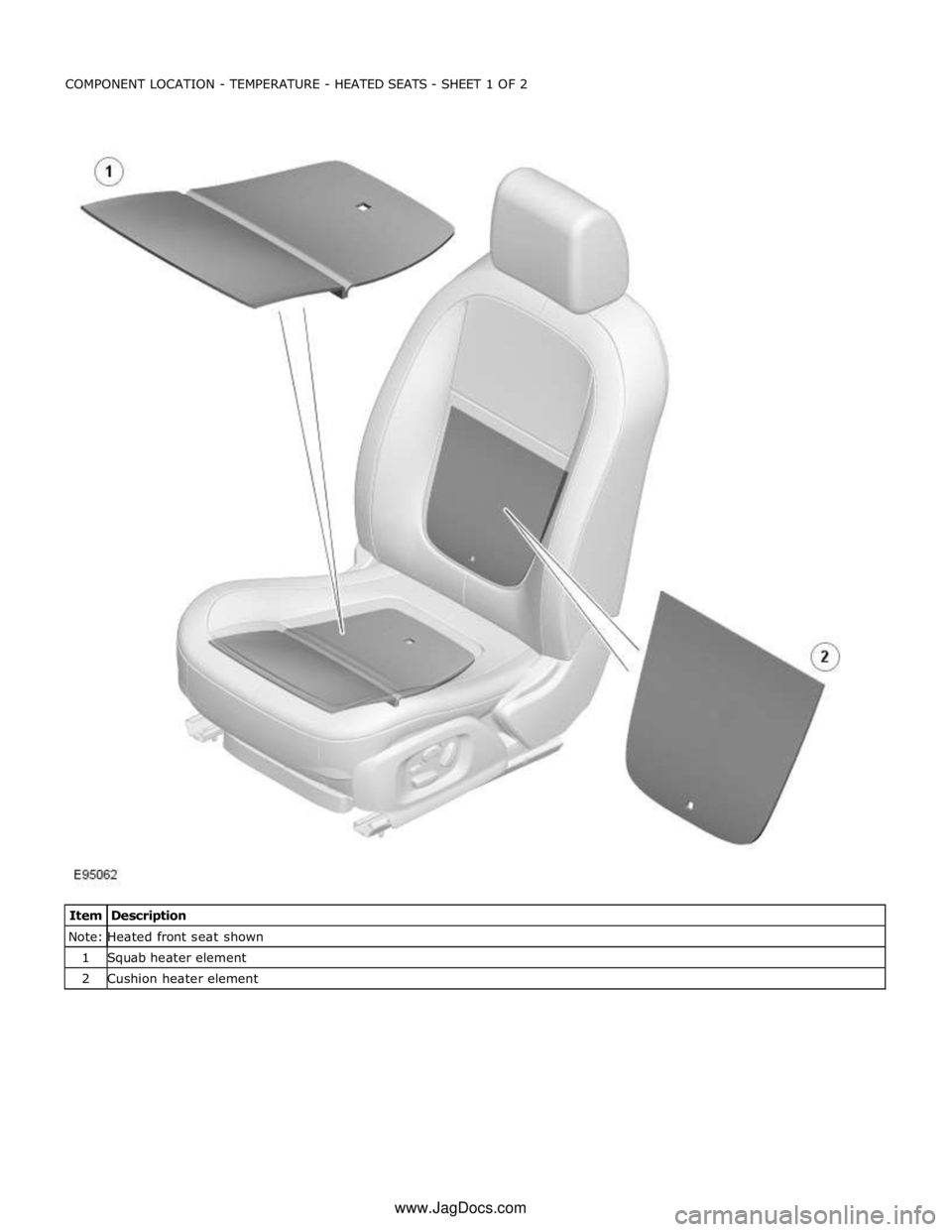
Note: Heated front seat shown 1 Squab heater element 2 Cushion heater element www.JagDocs.com
Page 2315 of 3039
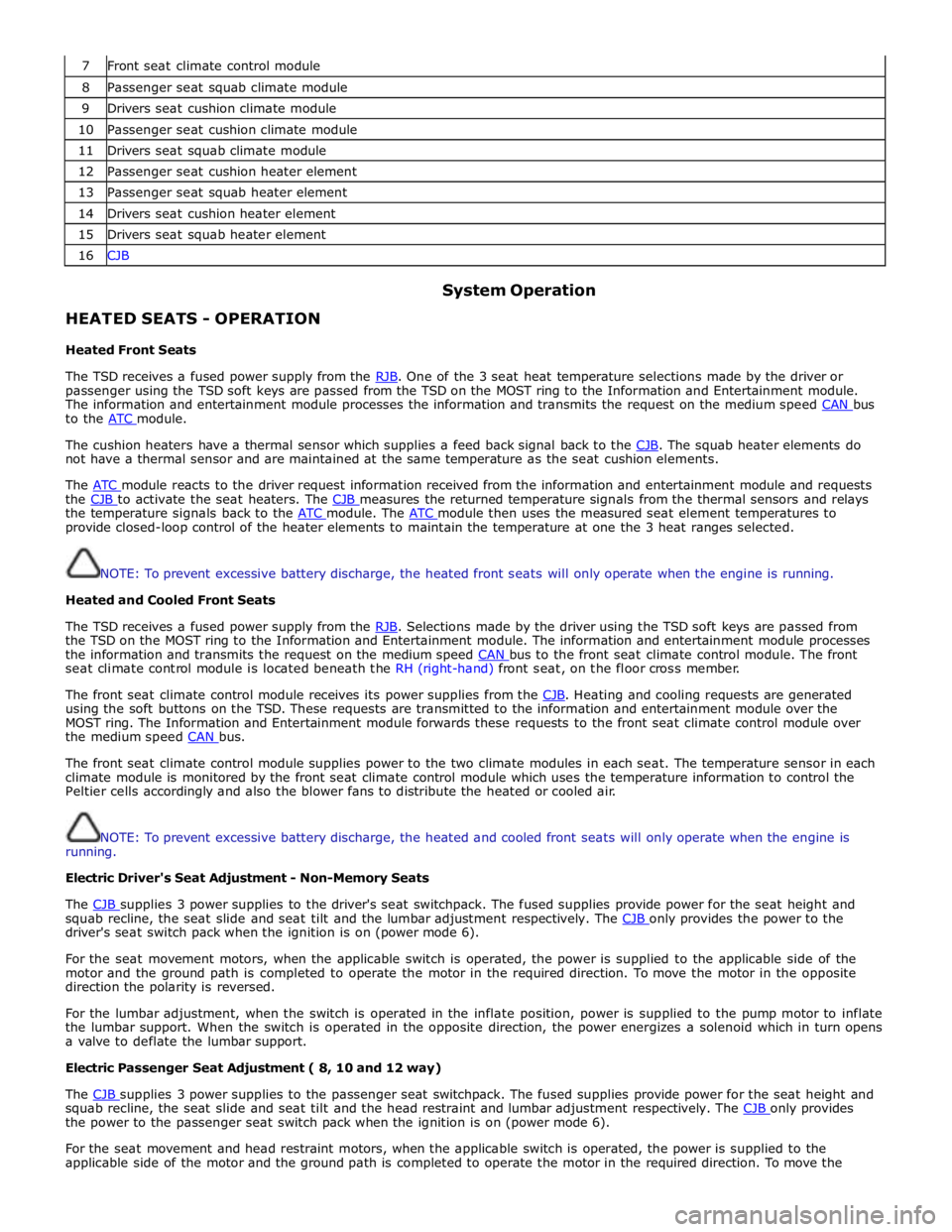
7 Front seat climate control module 8 Passenger seat squab climate module 9 Drivers seat cushion climate module 10 Passenger seat cushion climate module 11 Drivers seat squab climate module 12 Passenger seat cushion heater element 13 Passenger seat squab heater element 14 Drivers seat cushion heater element 15 Drivers seat squab heater element 16 CJB
HEATED SEATS - OPERATION
Heated Front Seats System Operation
The TSD receives a fused power supply from the RJB. One of the 3 seat heat temperature selections made by the driver or passenger using the TSD soft keys are passed from the TSD on the MOST ring to the Information and Entertainment module.
The information and entertainment module processes the information and transmits the request on the medium speed CAN bus to the ATC module.
The cushion heaters have a thermal sensor which supplies a feed back signal back to the CJB. The squab heater elements do not have a thermal sensor and are maintained at the same temperature as the seat cushion elements.
The ATC module reacts to the driver request information received from the information and entertainment module and requests the CJB to activate the seat heaters. The CJB measures the returned temperature signals from the thermal sensors and relays the temperature signals back to the ATC module. The ATC module then uses the measured seat element temperatures to provide closed-loop control of the heater elements to maintain the temperature at one the 3 heat ranges selected.
NOTE: To prevent excessive battery discharge, the heated front seats will only operate when the engine is running.
Heated and Cooled Front Seats
The TSD receives a fused power supply from the RJB. Selections made by the driver using the TSD soft keys are passed from the TSD on the MOST ring to the Information and Entertainment module. The information and entertainment module processes
the information and transmits the request on the medium speed CAN bus to the front seat climate control module. The front seat climate control module is located beneath the RH (right-hand) front seat, on the floor cross member.
The front seat climate control module receives its power supplies from the CJB. Heating and cooling requests are generated using the soft buttons on the TSD. These requests are transmitted to the information and entertainment module over the
MOST ring. The Information and Entertainment module forwards these requests to the front seat climate control module over
the medium speed CAN bus.
The front seat climate control module supplies power to the two climate modules in each seat. The temperature sensor in each
climate module is monitored by the front seat climate control module which uses the temperature information to control the
Peltier cells accordingly and also the blower fans to distribute the heated or cooled air.
NOTE: To prevent excessive battery discharge, the heated and cooled front seats will only operate when the engine is
running.
Electric Driver's Seat Adjustment - Non-Memory Seats
The CJB supplies 3 power supplies to the driver's seat switchpack. The fused supplies provide power for the seat height and squab recline, the seat slide and seat tilt and the lumbar adjustment respectively. The CJB only provides the power to the driver's seat switch pack when the ignition is on (power mode 6).
For the seat movement motors, when the applicable switch is operated, the power is supplied to the applicable side of the
motor and the ground path is completed to operate the motor in the required direction. To move the motor in the opposite
direction the polarity is reversed.
For the lumbar adjustment, when the switch is operated in the inflate position, power is supplied to the pump motor to inflate
the lumbar support. When the switch is operated in the opposite direction, the power energizes a solenoid which in turn opens
a valve to deflate the lumbar support.
Electric Passenger Seat Adjustment ( 8, 10 and 12 way)
The CJB supplies 3 power supplies to the passenger seat switchpack. The fused supplies provide power for the seat height and squab recline, the seat slide and seat tilt and the head restraint and lumbar adjustment respectively. The CJB only provides the power to the passenger seat switch pack when the ignition is on (power mode 6).
For the seat movement and head restraint motors, when the applicable switch is operated, the power is supplied to the
applicable side of the motor and the ground path is completed to operate the motor in the required direction. To move the
Page 2316 of 3039

supplies provide power for the movement motors in addition to the driver's seat switch pack. Power is only supplied to the
driver's seat module and the driver's seat switch pack when the ignition is on (power mode 6).
The driver's seat switch pack is connected to the driver's seat module by a LIN bus for the seat movement switches. Any selection for seat movement generates a message which is passed via the LIN to the driver's seat module. The seat module processes the request and operates the applicable seat function as required using the power supplies from the CJB.
Each seat motor contains a Hall position sensor. The sensor sends a feedback signal to the driver's seat module. The signal is
used for memory store and memory recall functions.
The lumbar adjustment switch on the driver's seat switch pack is wired direct to the lumbar pump and solenoids. The switch,
when moved to the inflate position for either the upper or lower inflatable cushion cell, provides a power supply to the lumbar
pump and simultaneously activates the applicable inflate solenoid valve. When the switch is released the pump stops and the
solenoid valve closes trapping the air in the inflatable cushion. When the switch is moved to the deflate position for either the
upper or lower inflatable cushion cell, power is supplied to the applicable deflate solenoid valve which opens to allow the air in
the cushion to escape. When the switch is released, the valve is closed and the remaining air in the cushion is retained.
FRONT SEATS - DESCRIPTION Component Description
The table below highlights the features available for each seating option.
Seat Type Non-Heated Heated Heated and Cooled Lumbar Support Memory 8-way Yes Optional No 2-way No 10-way Yes Optional Optional 2-way Optional (Driver's seat only) 12-way No No Yes 4-way No 16-way No No Yes 4-way Yes (Driver's seat only) Seat Heating
The 3-stage heated front seats feature 2 heater elements located in the seat cushion and a single heater element located in
the seat squab. Operation of the heated front seats is controlled by the ATC module via the TSD, information and entertainment control module and the CJB module on vehicles with heated seats. On vehicles with heated and cooled seats the operation is controlled by the TSD, information and entertainment control module and the front seat climate control
module.
The heated and cooled front seats each contain 2 climate modules; one in the cushion, one in the squab. The climate modules
contain 'Peltier' cells which are able to deliver heating and cooling based on a voltage provided by the front seat climate
control module. Each climate module also contains a fan, which blows air over the Peltier cells to distribute heated or cooled
air via liners in the seat cushion and squab. The fan is also controlled by the front seat climate control module. The TSD allows
the driver and passenger to select 3 ranges of heated or cooled ventilation; off, minimum and intermediate. Also, using the
selections on the TSD, the driver and passenger can select between full seat ventilation or squab backrest ventilation only.
Vehicles fitted with the 3-stage heated front seat option also feature a heated steering wheel.
Refer to: Steering Column Switches (211-05 Steering Column Switches, Description and Operation).
Electric Seat Adjustment
Lumbar Support
On 8, 10 and 12 way seats, a 2 way lumbar support is provided which allows the lumbar inflatable cushion to be inflated or
deflated as required. On 16 way seats, a 4 way lumbar support is fitted which comprises two separate cushion cells. The upper
and lower cells can be inflated or deflated individually allowing greater comfort adjustment for the driver and passenger.
The lumbar support comprises an inflatable cushion located in the seat squab, a pump and solenoids. The pump is activated
when the applicable seat switch is moved to the inflate position, inflating the cell(s) in the inflatable cushion. On 8 and 10
way seats, a single solenoid operated valve allows the inflatable cushion to be deflated. On 12 and 16 way seats, 4 solenoid
valves control the inflation and deflation of the upper and lower inflatable cushion cells, allowing each cell to be adjusted
individually.
Seat Motors
The head restraint motor is located in the upper section of each seat squab and is accessible by removal of the seat back. The
motor moves a cradle which is driven in a vertical motion by a rack and pinion arrangement. The cradle has the two head
restraint stems attached to it and therefore raises and lowers the head restraint as the motor moves the cradle. The motor
contains a Hall sensor which supplies positional information to the driver's seat module.
The seat slide motor is an integral component of the seat frame. The motor drives on a gear on a worm drive lead screw which
is integral with the floor rail. The lead screw has a stop at each end to limit the fore and aft seat movement.
Page 2337 of 3039
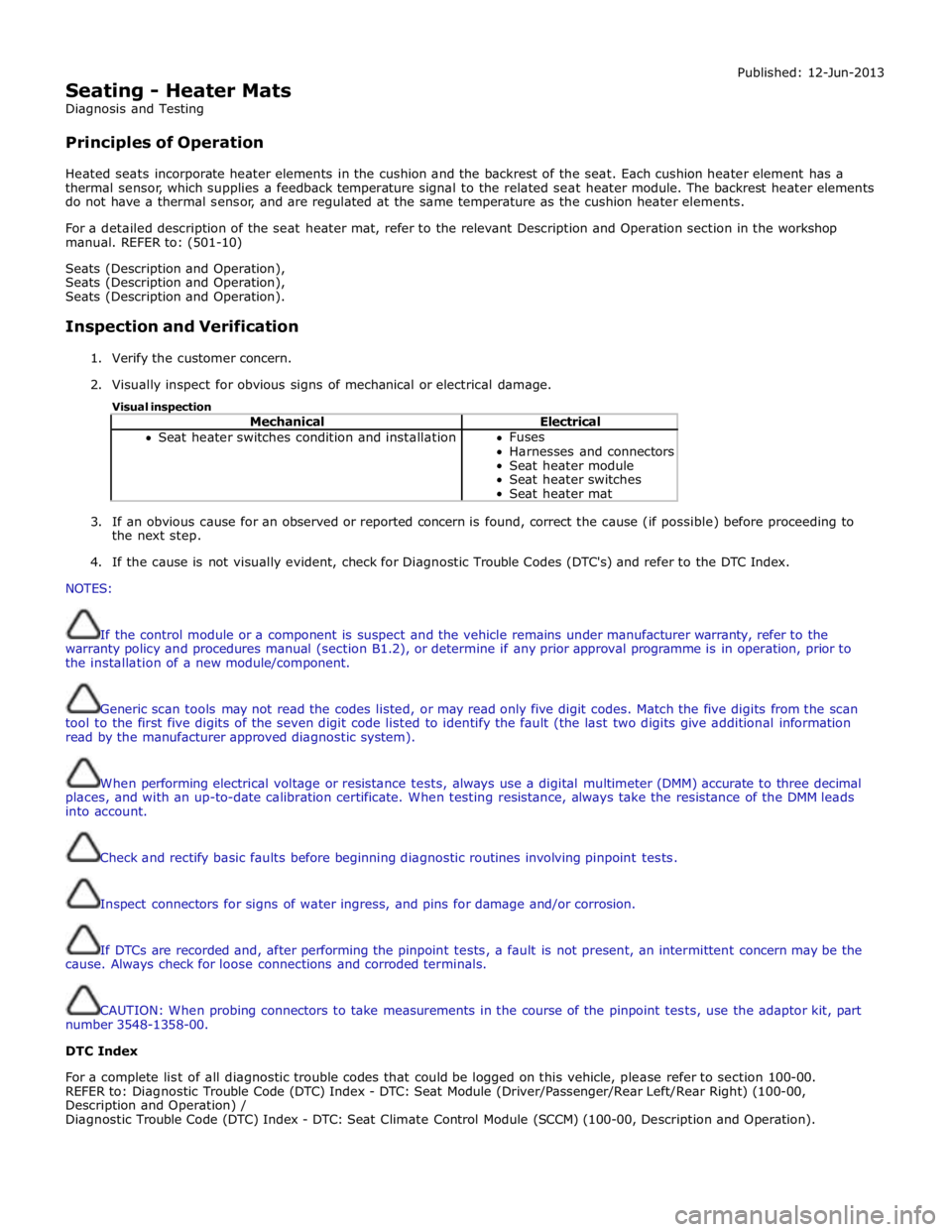
Seating - Heater Mats
Diagnosis and Testing
Principles of Operation Published: 12-Jun-2013
Heated seats incorporate heater elements in the cushion and the backrest of the seat. Each cushion heater element has a
thermal sensor, which supplies a feedback temperature signal to the related seat heater module. The backrest heater elements
do not have a thermal sensor, and are regulated at the same temperature as the cushion heater elements.
For a detailed description of the seat heater mat, refer to the relevant Description and Operation section in the workshop
manual. REFER to: (501-10)
Seats (Description and Operation),
Seats (Description and Operation),
Seats (Description and Operation).
Inspection and Verification
1. Verify the customer concern.
2. Visually inspect for obvious signs of mechanical or electrical damage.
Visual inspection
Mechanical Electrical Seat heater switches condition and installation Fuses
Harnesses and connectors
Seat heater module
Seat heater switches
Seat heater mat
3. If an obvious cause for an observed or reported concern is found, correct the cause (if possible) before proceeding to
the next step.
4. If the cause is not visually evident, check for Diagnostic Trouble Codes (DTC's) and refer to the DTC Index.
NOTES:
If the control module or a component is suspect and the vehicle remains under manufacturer warranty, refer to the
warranty policy and procedures manual (section B1.2), or determine if any prior approval programme is in operation, prior to
the installation of a new module/component.
Generic scan tools may not read the codes listed, or may read only five digit codes. Match the five digits from the scan
tool to the first five digits of the seven digit code listed to identify the fault (the last two digits give additional information
read by the manufacturer approved diagnostic system).
When performing electrical voltage or resistance tests, always use a digital multimeter (DMM) accurate to three decimal
places, and with an up-to-date calibration certificate. When testing resistance, always take the resistance of the DMM leads
into account.
Check and rectify basic faults before beginning diagnostic routines involving pinpoint tests.
Inspect connectors for signs of water ingress, and pins for damage and/or corrosion.
If DTCs are recorded and, after performing the pinpoint tests, a fault is not present, an intermittent concern may be the
cause. Always check for loose connections and corroded terminals.
CAUTION: When probing connectors to take measurements in the course of the pinpoint tests, use the adaptor kit, part
number 3548-1358-00.
DTC Index
For a complete list of all diagnostic trouble codes that could be logged on this vehicle, please refer to section 100-00.
REFER to: Diagnostic Trouble Code (DTC) Index - DTC: Seat Module (Driver/Passenger/Rear Left/Rear Right) (100-00,
Description and Operation) /
Diagnostic Trouble Code (DTC) Index - DTC: Seat Climate Control Module (SCCM) (100-00, Description and Operation).
Page 2338 of 3039

Seat Heater Mat Application Chart
NOTE: To ensure an accurate resistance reading, calibrated test equipment must be used
Vehicle /
Year
Cushion /
Backrest
Heater Mat
/ NTC
Resistor
Left Hand Drive
Right Hand Drive Minimum
Resistance Maximum
Resistance Passenger
Side
Connector /
Pin
Driver Side
Connector /
Pin Passenger
Side
Connector /
Pin
Driver Side
Connector /
Pin
Ohms At
20°C ±10°C
Ohms At
20°C ±10°C XK 2010 Cushion Heater mat
PS002/1 and
PS002/4 DS002/1 and
DS002/4 PS002/1 and
PS002/4 DS002/1 and
DS002/4 1,2 1,6 NTC resistor
PS002/2 and
PS002/3 DS002/2 and
DS002/3 PS002/2 and
PS002/3 DS002/2 and
DS002/3 4 000 10 000 Backrest Heater mat
PS003/1 and
PS003/2 DS003/1 and
DS003/2 PS003/1 and
PS003/2 DS003/1 and
DS003/2 0,35 0,47 XF Cushion Heater mat
C3HS07A/1 and
C3HS07A/4 C3HS02A/1
and
C3HS02A/4 C3HS07A/1 and
C3HS07A/4 C3HS02A/1
and
C3HS02A/4 1,23 1,64 NTC resistor
C3HS07A/2 and
C3HS07A/3 C3HS02A/2
and
C3HS02A/3 C3HS07A/2 and
C3HS07A/3 C3HS02A/2
and
C3HS02A/3 4 000 10 000 Backrest Heater mat
C3HS06A/1 and
C3HS06A/2 C3HS01A/1
and
C3HS01A/2 C3HS06A/1 and
C3HS06A/2 C3HS01A/1
and
C3HS01A/2 0,82 1,09 XJ 2008 Cushion Heater mat
SP14-1 and
SP14-4 SD14-1 and
SD14-4 SP14-1 and
SP14-4 SD14-1 and
SD14-4 1,28 1,71 NTC resistor
SP14-2 and
SP14-3 SD14-2 and
SD14-3 SP14-2 and
SP14-3 SD14-2 and
SD14-3 4 000 10 000 Backrest Heater mat
SP15-1 and
SP15-2 SD15-1 and
SD15-2 SP15-1 and
SP15-2 SD15-1 and
SD15-2 0,88 1,17 XJ 2010
onwards -
Front Cushion Heater mat
C3HS07/1 and
C3HS07/4 C3HS02/1 and
C3HS02/4 C3HS07/1 and
C3HS07/4 C3HS02/1 and
C3HS02/4 0,99 1,32 NTC resistor
C3HS07/2 and
C3HS07/3 C3HS02/2 and
C3HS02/3 C3HS07/2 and
C3HS07/3 C3HS02/2 and
C3HS02/3 4 000 10 000 Backrest Heater mat
C3HS06/1 and
C3HS06/2 C3HS01/1 and
C3HS01/2 C3HS06/1 and
C3HS06/2 C3HS01/1 and
C3HS01/2 0,67 0,90 XJ 2010
onwards -
Rear Cushion Heater mat
C3HS78/1 and
C3HS78/4 C3HS76/1 and
C3HS76/4 C3HS76/1 and
C3HS76/4 C3HS78/1 and
C3HS78/4 0,99 1,32 NTC resistor
C3HS78/2 and
C3HS78/3 C3HS76/2 and
C3HS76/3 C3HS76/2 and
C3HS76/3 C3HS78/2 and
C3HS78/3 4 000 10 000 Backrest Heater mat
C3HS79/1 and
C3HS79/4 C3HS77/1 and
C3HS77/4 C3HS77/1 and
C3HS77/4 C3HS79/1 and
C3HS79/4 1,0 1,3
PINPOINT TEST A : SEAT HEATER MAT TEST
CONDITIONS DETAILS/RESULTS/ACTIONS A1: CHECK FOR DTC'S 1 Where possible use the manufacturer approved diagnostic system to review any logged seat heater mat DTC's Were any seat heater mat DTC's logged?
Yes
Carry out the help text action for any logged DTC's. Clear the DTC and retest. If DTC's return follow the
tests listed below GO to A2. No
GO to A2. A2: MANUAL CHECK NOTES:
The manual check should be carried out by someone familiar with correct seat heat operation
On full power the seat should be hot to touch 1 If required operate the vehicle air conditioning on full for 10 minutes to reduce the in vehicle ambient temperature 2 Operate the seat heater on full power Does the seat heater operate correctly?
Yes
Clear any stored DTC's and retest. If seat heater operation is correct no further action required
No
GO to A3. A3: SHORT CIRCUIT TO GROUND
Page 2339 of 3039
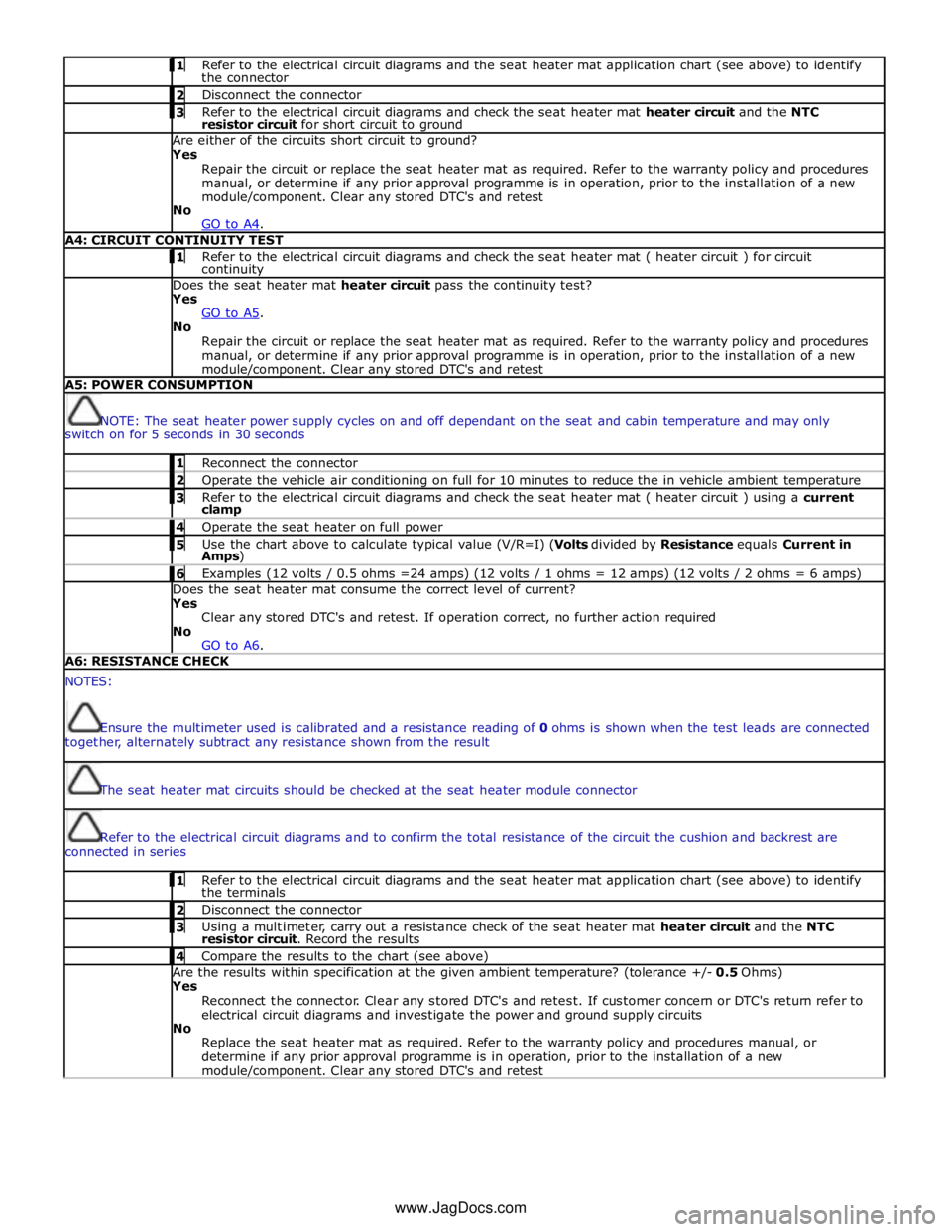
1 Refer to the electrical circuit diagrams and the seat heater mat application chart (see above) to identify the connector 2 Disconnect the connector 3 Refer to the electrical circuit diagrams and check the seat heater mat heater circuit and the NTC resistor circuit for short circuit to ground Are either of the circuits short circuit to ground?
Yes
Repair the circuit or replace the seat heater mat as required. Refer to the warranty policy and procedures
manual, or determine if any prior approval programme is in operation, prior to the installation of a new
module/component. Clear any stored DTC's and retest
No
GO to A4. A4: CIRCUIT CONTINUITY TEST 1 Refer to the electrical circuit diagrams and check the seat heater mat ( heater circuit ) for circuit continuity Does the seat heater mat heater circuit pass the continuity test?
Yes
GO to A5. No
Repair the circuit or replace the seat heater mat as required. Refer to the warranty policy and procedures
manual, or determine if any prior approval programme is in operation, prior to the installation of a new module/component. Clear any stored DTC's and retest A5: POWER CONSUMPTION
NOTE: The seat heater power supply cycles on and off dependant on the seat and cabin temperature and may only
switch on for 5 seconds in 30 seconds 1 Reconnect the connector 2 Operate the vehicle air conditioning on full for 10 minutes to reduce the in vehicle ambient temperature 3 Refer to the electrical circuit diagrams and check the seat heater mat ( heater circuit ) using a current clamp 4 Operate the seat heater on full power 5 Use the chart above to calculate typical value (V/R=I) (Volts divided by Resistance equals Current in Amps) 6 Examples (12 volts / 0.5 ohms =24 amps) (12 volts / 1 ohms = 12 amps) (12 volts / 2 ohms = 6 amps) Does the seat heater mat consume the correct level of current?
Yes
Clear any stored DTC's and retest. If operation correct, no further action required
No
GO to A6. A6: RESISTANCE CHECK NOTES:
Ensure the multimeter used is calibrated and a resistance reading of 0 ohms is shown when the test leads are connected
together, alternately subtract any resistance shown from the result
The seat heater mat circuits should be checked at the seat heater module connector
Refer to the electrical circuit diagrams and to confirm the total resistance of the circuit the cushion and backrest are
connected in series 1 Refer to the electrical circuit diagrams and the seat heater mat application chart (see above) to identify the terminals 2 Disconnect the connector 3 Using a multimeter, carry out a resistance check of the seat heater mat heater circuit and the NTC resistor circuit. Record the results 4 Compare the results to the chart (see above) Are the results within specification at the given ambient temperature? (tolerance +/- 0.5 Ohms)
Yes
Reconnect the connector. Clear any stored DTC's and retest. If customer concern or DTC's return refer to
electrical circuit diagrams and investigate the power and ground supply circuits
No
Replace the seat heater mat as required. Refer to the warranty policy and procedures manual, or
determine if any prior approval programme is in operation, prior to the installation of a new module/component. Clear any stored DTC's and retest www.JagDocs.com
Page 2340 of 3039
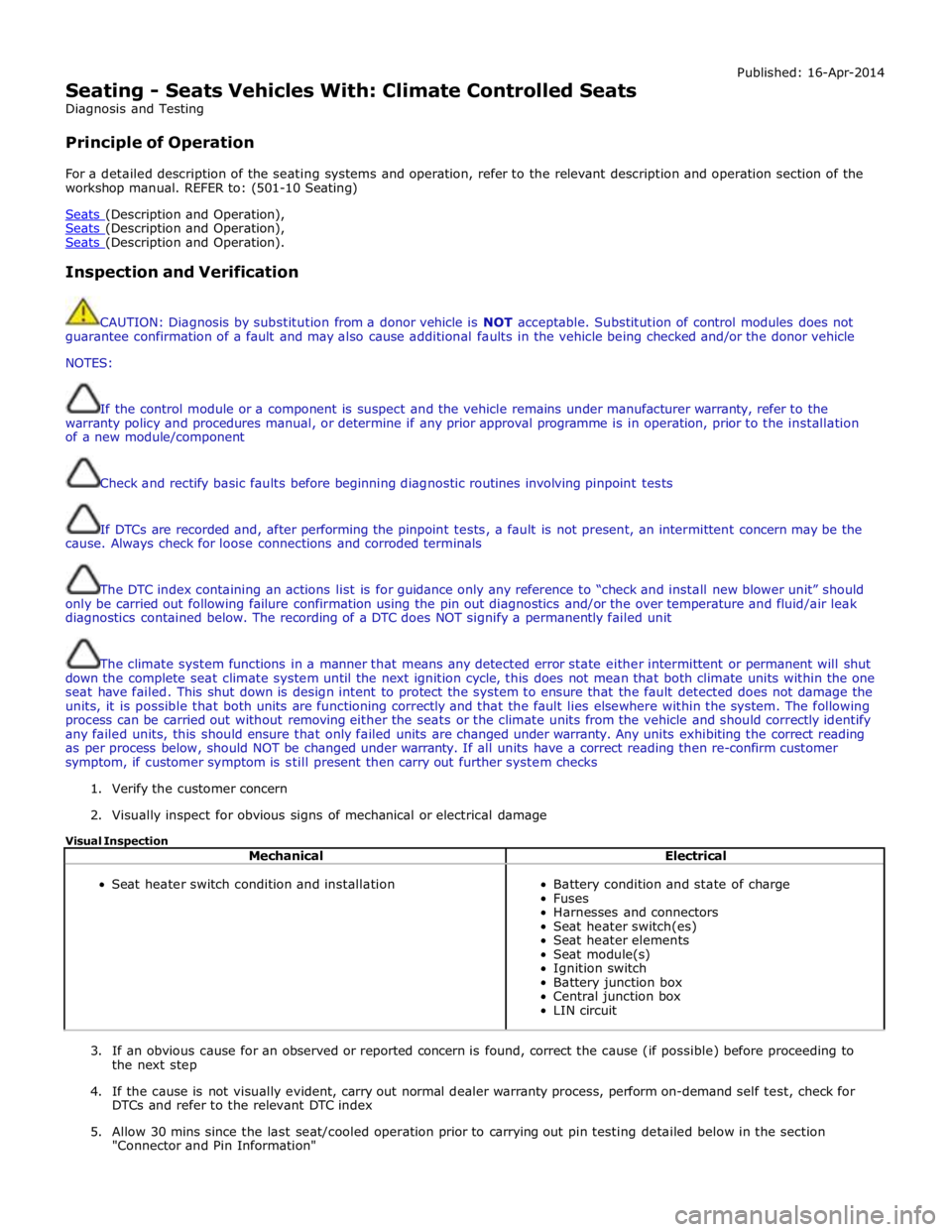
Seating - Seats Vehicles With: Climate Controlled Seats
Diagnosis and Testing
Principle of Operation Published: 16-Apr-2014
For a detailed description of the seating systems and operation, refer to the relevant description and operation section of the
workshop manual. REFER to: (501-10 Seating)
Seats (Description and Operation), Seats (Description and Operation), Seats (Description and Operation).
Inspection and Verification
CAUTION: Diagnosis by substitution from a donor vehicle is NOT acceptable. Substitution of control modules does not
guarantee confirmation of a fault and may also cause additional faults in the vehicle being checked and/or the donor vehicle
NOTES:
If the control module or a component is suspect and the vehicle remains under manufacturer warranty, refer to the
warranty policy and procedures manual, or determine if any prior approval programme is in operation, prior to the installation
of a new module/component
Check and rectify basic faults before beginning diagnostic routines involving pinpoint tests
If DTCs are recorded and, after performing the pinpoint tests, a fault is not present, an intermittent concern may be the
cause. Always check for loose connections and corroded terminals
The DTC index containing an actions list is for guidance only any reference to “check and install new blower unit” should
only be carried out following failure confirmation using the pin out diagnostics and/or the over temperature and fluid/air leak
diagnostics contained below. The recording of a DTC does NOT signify a permanently failed unit
The climate system functions in a manner that means any detected error state either intermittent or permanent will shut
down the complete seat climate system until the next ignition cycle, this does not mean that both climate units within the one
seat have failed. This shut down is design intent to protect the system to ensure that the fault detected does not damage the
units, it is possible that both units are functioning correctly and that the fault lies elsewhere within the system. The following
process can be carried out without removing either the seats or the climate units from the vehicle and should correctly identify
any failed units, this should ensure that only failed units are changed under warranty. Any units exhibiting the correct reading
as per process below, should NOT be changed under warranty. If all units have a correct reading then re-confirm customer
symptom, if customer symptom is still present then carry out further system checks
1. Verify the customer concern
2. Visually inspect for obvious signs of mechanical or electrical damage
Visual Inspection
Mechanical Electrical
Seat heater switch condition and installation
Battery condition and state of charge
Fuses
Harnesses and connectors
Seat heater switch(es)
Seat heater elements
Seat module(s)
Ignition switch
Battery junction box
Central junction box
LIN circuit
3. If an obvious cause for an observed or reported concern is found, correct the cause (if possible) before proceeding to
the next step
4. If the cause is not visually evident, carry out normal dealer warranty process, perform on-demand self test, check for
DTCs and refer to the relevant DTC index
5. Allow 30 mins since the last seat/cooled operation prior to carrying out pin testing detailed below in the section
"Connector and Pin Information"